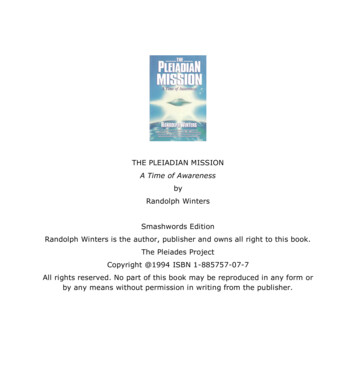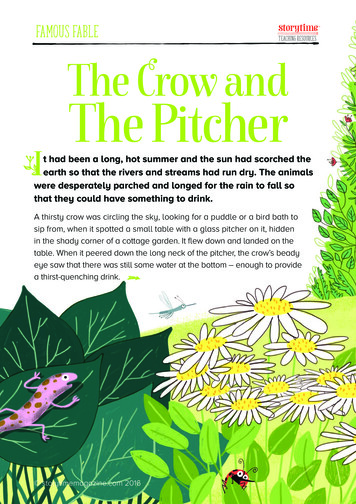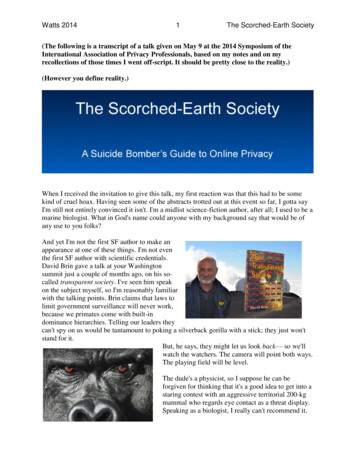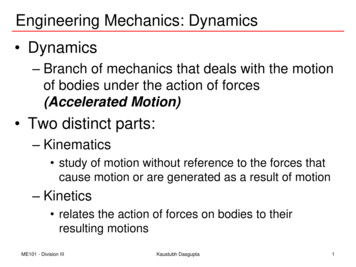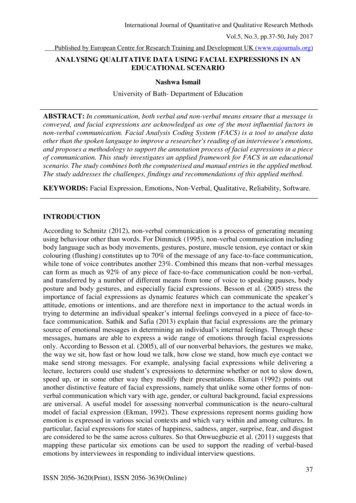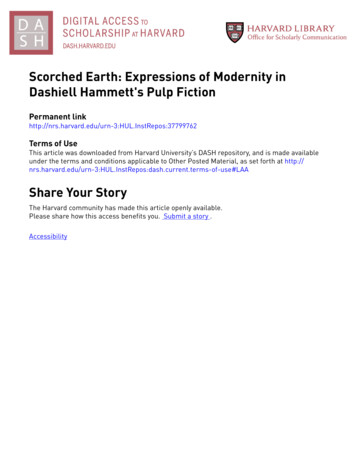
Transcription
Scorched Earth: Expressions of Modernity inDashiell Hammett's Pulp FictionPermanent 99762Terms of UseThis article was downloaded from Harvard University’s DASH repository, and is made availableunder the terms and conditions applicable to Other Posted Material, as set forth at rrent.terms-of-use#LAAShare Your StoryThe Harvard community has made this article openly available.Please share how this access benefits you. Submit a story .Accessibility
Scorched Earth: Expressions of Modernity in Dashiell Hammett’s Pulp FictionAnna P. KellyA Thesis in the Field of English Literaturefor the Degree of Master of Liberal Arts in Extension StudiesHarvard UniversityNovember 2017
AbstractSamuel Dashiell Hammett (“Dash”), American author and activist, is today bestknown for one of the novels he published 1930, The Maltese Falcon. My thesis presentsevidence that a close study of a selection of Hammett’s short stories and novels publishedbetween 1925 and 1930 (“Dead Yellow Women,” “The Scorched Face,” “The Gutting ofCouffignal,” Red Harvest, and The Maltese Falcon) exposes his personal struggle withmodernity in America, through a discussion of three motifs. In his stories and novels,Hammett explores the fluctuating treatment of immigrants, and changing social spacesfor newly independent women in post-World War I America. He also questions theconsequences of increasing mechanization in cities, through everyman detectives SamSpade and the Continental Op. As Hammett’s career progresses, he continues topassionately challenge the benefits of conservative cultural values, while urging cautionagainst the unreserved embrace of modernism.Research for this paper originated with a close study of Hammett’s letters, andseveral biographies (including Layman and Ward). A range of critics contributed to adiscussion of Hammett as a modernist author (e.g. Wheat and Norman). Articles on postWorld War I literature were also essential to my research (e.g. Tate and Stevenson). Areview of the available material demonstrated the need to analyze Hammett’s complexrelationship with modernity, and how the bond evolved over time. While Hammettestablishes specific motifs early in his career, it is not until 1930 that he standardizes his
unique portrayal of modernism in American cities, and urges readers to approachmodernism in America with cautious optimism.
Table of ContentsChapter I. Introduction .1Chapter II. The Continental Op Stories: “The Scorched Face,” “Dead Yellow Women,”and “The Gutting of Couffignal” .11"The Scorched Face" .15"Dead Yellow Women" .26"The Gutting of Couffignal" .36Chapter III. Red Harvest .44Chapter IV. The Maltese Falcon .66Chapter V Conclusion .86Works Cited .92
Chapter I.IntroductionDashiell Hammett’s career as an author began in the early 20th century, when hepublished short stories and sketches (sometimes under a pseudonym) for popularmagazines of the time. His first publication came in 1923 (Ward 81). Novels,particularly pulp novels, were widely read in their heyday, and were absorbed byhundreds of Americans daily. Named after their cheap production method (the term“pulp fiction” refers to the low-quality paper the stories were printed on), critic DanielMolin notes they were easily accessible and economically affordable for a broadaudience, appealing to highbrow and lowbrow readers alike (Molin 238). Given thedisposable production methods of pulp fiction in the early 20th Century, it is a testamentto the enduring popularity of Hammett’s fiction that his work is still studied by critics andacademics alike.My thesis presents evidence that a close reading of the Continental Op stories andThe Maltese Falcon shows evidence of Hammett’s personal struggle with modernity,through a study of the effect modernism had on American cities and citizens. Early signsof his political and social activism, which biographers Layman and Ward suggest is thefocus of Hammett’s interest later his life, also are on display in the published stories andnovels. Through two stereotypical detectives, the Continental Op and Sam Spade,Hammett is able to draw readers into a conversation about the rapidly changing socialconventions and the implicit dangers of increased mechanization in cities. Although he is1
not a prominent part of the discussion of fiction between World War I and World War II,recent critics continue to study his work, and recognize the novels and stories as critiquesof America. Their studies, however, tend to be narrowly focused on individual works hepublished, and do not trace his evolving impressions of modernism over the course of hiscareer.Hammett’s novels, which quickly became stalwarts of pulp fiction beginning inthe 1920’s, have city streets full of gangsters and molls, corruption permeating everyscene, and violence threatening to overrun city limits. However, despite the generalemphasis in pulp fiction on shocking bursts of violence, dramatic showdowns betweenheroic detectives and devious villains, and other scenes of lurid excess, Hammett’smessage lies elsewhere. Hammett quickly moved past the extreme violence, turning hisfocus to three indicators of modernity, as he struggled to acclimate to expressions ofmodernity in post-World War I America. The indicators he follows and turns his focustowards include a discussion of the changing social spaces for women, promotingincreasing integration of immigrants in American communities, and questioning theimpact of increasing mechanization in cities. Hammett’s nuanced approach to discussingthese three indicators over the course of his career is an essential lens through whichreaders understand his tumultuous personal relationship with modernity. In the earlyContinental Op stories, he establishes the narrative patterns he will follow throughout hiscareer, but shortly later, in Red Harvest (1929), his anxiety about modernism reaches newheights. Finally, in The Maltese Falcon (1930), his most financially lucrative anduniversally admired publication, Hammett’s theories about modernism become morerestrained, and are less alarmist.2
In Dashiell Hammett’s writing, he uses the familiar framework of a detectivenovel, but diverges from his contemporaries by deliberately integrating vernacularlanguage. This might be part of his effort to bolster an already-loyal readership for pulpmagazines, but is part of his ongoing discussion of modernism with readers. Althoughmany critics recognize Hammett as one of the founding fathers of pulp fiction, they oftencritique his successor’s writing in their work (Raymond Chandler). By initiallyoverlooking Hammett in favor of Chandler, scholarly journals and publications do astudy of modernism in literature a great disservice. Despite the fact that Hammett’snovels are not as widely studied by critics as Chandler’s are, the stories offer an equallyvaluable contribution to an analysis of modernism in literature between World War I andWorld War II. The Op and Spade offer similar insights into a study of modernity, and theauthor’s struggles to come to terms with the challenges of a rapidly changing socialstructure.The stories and novels discussed in this paper (“Dead Yellow Women,” “TheScorched Face,” “The Gutting of Couffignal,” Red Harvest and The Maltese Falcon)feature two of Hammett’s most familiar detectives: The everyman Continental Op, andPrivate Investigator Sam Spade. When Hammett successfully submitted “The ScorchedFace” for publication in May 1925, he had already published more than a dozen storiesfeaturing the Continental Op. Hammett’s maintains a steady rate of production for anumber of years: “The Scorched Face” is one of ten stories Hammett has published in1925. Hammett’s first novel, Red Harvest, is published in 1929, and also features theContinental Op. A year later, in 1930, Hammett publishes what will become his mostwell-known novel, The Maltese Falcon, with detective Sam Spade. The Maltese Falcon3
is the novel which has been most frequently transferred from page to screen. BiographerNathan Ward also remarks on the novel’s unusual popularity in Hollywood, as he detailsthe three film versions made within a ten-year span following publication (Ward 1). Themost famous version was produced in 1941, and featured a notable cast, includingHumphry Bogart and Peter Lorre. Additionally, Ward suggests that this is the novel thatsolidifies Hammett’s status as a celebrity in literary circles (Ward 1).Hammett’s rapid-fire publication rate was partially driven by necessity. By thetime he wrote The Maltese Falcon, his family included his wife (an army nurse he wasseparated from), and two daughters he was helping support. As his rate of publicationincreased, his social conscience became increasingly developed. While this does notindicate anything about his audience’s social or political preferences, it does imply thatHammett’s underlying discussion of modernity was reaching a broader group of readers.As Hammett’s writing career advanced, his narrative style features an increasinglypointed discussion of modernity in America.Many critiques are anchored in the fact that detectives Sam Spade and theContinental Op are echoes of Hammett. This is something Hammett himself alludes to inhis letters and correspondence, and which contributes to an understanding of his novels associal critiques (Hammett 343). Hammett’s underlying discussion of modernityconsistently evolves in time, influenced by his personal life, and becomes more nuancedas his career progresses. He does not lose sight of his activism as his writing evolves,remaining a politically active and sympathetic to the Communist cause for a number ofyears. Unfortunately, his arrest for being a Communist sympathizer, and his subsequentimprisonment, further damaged his chronically poor health: He died in New York City in4
1961. The research for this paper is heavily influenced by Hammett’s biography, andhighlights the strong bond between author and his detectives. Through the twoinvestigators, readers are lead through a nuanced and complicated discussion of theeffects of modernism in America.Hammett’s decision as an author, to break predictable narrative patterns andcharacter types, resonates with readers. In his short stories and novels, Hammett firstbrings his detectives into close working relationships with immigrants, before proceedingto humanize the foreign men and women who increasingly populate American cities. InThe Maltese Falcon, the character who exemplifies this transformation is con-man andGreek immigrant Joel Cairo. Instead of being isolated or caricatured, Cairo is a fullyintegrated part of the narrative. Hammett often successfully incorporates characters intothe main story by constructing parallel narratives, and drawing similarities between thelives of immigrants and his detectives. Similarly, Hammett overturns traditional literarydepictions of women in society. Initially, his short stories feature two distinctexpressions of femininity: Women who cling to traditional expectations of gender roles,and those who do not. Hammett challenges these blunt character stereotypes byexploring the newly acceptable social spaces women occupy in post-World War IAmerican cities. To do this, Hammett often creates a clear distance between culturallyaccepted roles of mother and wife, and the dangerous and independent femme fatale (anew type of woman, who thrives in cities with or without men). The two expressions offemininity are initially at odds, but in The Maltese Falcon, readers see the successfulcombination of modern freedoms and social expectations for women, through EffiePerine (Spade’s secretary), and treasure-hunter Brigid O’Shaughnessy.5
The final expression of modernity Hammett explores is the Op and Spade’sshared complex relationship with machines, often discussed through the effect increasingmechanization is having in cities. Initially, machines (Hammett focuses on automobiles,telephones and machine guns) are portrayed as taking over urban spaces, or as bluntexpressions of wealth. However, as Hammett’s career progresses, his detectives begin tointegrate various forms of modern technology into their lives. While his descriptions ofcars and telephones in “The Gutting of Couffignal” implies cars, telephones and machineguns are luxury items and status symbols, he challenges these preconceptions about theirsignificance. At the narrative climax, gangsters take over a wealthy island community,and steal all of the cars and guns, shifting the power structure on the island. In this scene,Hammett rewrites the traditional American social hierarchy, while modifying themeaning of these expensive and formidable machines. While readers may not be awareof Hammett’s social agenda, and how he promotes it on an underlying level, they willbegin to notice specific patterns as the individual narratives progress. The clearlyembedded political and social language embodied by these indicators, and by the specificrelationships Hammett focuses on, is clearly a condemnation of American’s easy andunquestioning acceptance of modernity.This paper is both steered by and directly influenced by Hammett’s personal life.Research for this thesis originated with several biographies, including Richard Layman’s“Shadow Man: The Life of Dashiell Hammett,” and Nathan Ward’s “The Lost Detective:Becoming Dashiell Hammett.” These sources, in conjunction with his novels, illustratethe ways in which the characterization of both the Continental Op and of Sam Spade washeavily influenced by Hammett’s personal life. A review of Hammett’s correspondence6
with family and friends offered additional insight into Dashiell Hammett’s politicalviews, and provided other useful background information from the people who knew himbest. Background information on Hammett’s service in the army, and his employmentwith the Pinkerton National Detective Agency, further enriched my understanding of theclose bond between Hammett’s life and his detectives’ backstories. Although Hammett’sservice in the army and time working for the Pinkerton National Detective Agency werebrief, lasting only a short time before he was discharged due to poor health, bothexperiences had a strong influence on the author, which is evident in his mystery novels.Critic Daniel Linder notes “Hammett certainly had met the real-life prototypes of JoelCairo, Caspar Gutman and Wilmer Cook” and “described the origin of many ofthe characters” to colleagues (Linder 9). Although Ward notes that none of his originalfiles are extant from Hammett’s cases as a detective, it is undeniable that the detectiveagency inspired his writing (Ward 8). Following my research into Hammett’sbackground, my inquiry shifted from available primary sources and biographies to thecurrent scholarship on Hammett’s short stories and novels. The critical approaches tostudying pulp fiction (and, more specifically, Dashiell Hammett) vary widely. However,starting in the 1970s, an increasing number of critics became interested in pulp fiction,and the critiques began to include a study of how American literature, includingHammett’s novels, was shaped by post-World War I political and social upheaval inAmerica (Philippa Gates, Trudi Tate, and Christopher Metress are examples of thiscritical approach). However, many of these critics neglect a discussion of howHammett’s work expresses the challenges of technology through three specific motifs heidentifies as crucial to the rapid spread of modernity in America.7
The first chapter following the introduction will focus on three of the short storiesHammett published in 1929 (“Dead Yellow Women,” “The Scorched Face,” and “TheGutting of Couffignal”), and his early attempts in identifying and questioning threespecific tropes of modernism. Hammett’s focus on the treatment of immigrants inAmerican society, changing social spaces women occupy in post-World War I America,and his evolving discussion of machines and technology is established in thesepublications. In addition, guns are often personified, as Hammett reimagines Americancity streets as the front lines of a battlefield. Automobiles and telephones are signs ofclass distinction and elitism in America, which Hammett protests against. Through hisdetectives, Hammett concludes increasing mechanization is a problematic symptom ofmodernity.Hammett builds upon these initial critiques of modernity in Red Harvest, thesubject of the next chapter. Red Harvest is Hammett’s most stereotypical pulp fictionnovel in a number of ways. In Red Harvest, the Op’s disillusionment with Americansociety reaches a dramatic peak. Violence in Personville (where the Op travels to cleanthe town of gangsters and solve a murder) is so widespread, it is spilling out of the townperimeter. The violence in Personville is enhanced by an equally troubling level ofcorruption that is systemically destroying the existing community structure from theinside out. As the mechanized violence and corruption increase, other forms oftechnology become omnipresent. The other aspects of Hammett’s social agenda – theinitial isolation and eventual integration of immigrants, and the dramatic increase inindependence women experience in post-WWI America – are also enhanced as hisideology becomes increasingly clear. In Red Harvest, there are dozens of character8
deaths in as many pages, and all characters are exaggerated and distorted. While thismisrepresentation, in conjunction with the increase in violence and crime, may haveappealed to an audience which enjoys rapid-fire plots and dramatic scenes, Hammett’ssocial critique is in danger of being buried by the scale of the narrative drama.In the third chapter, I will discuss Hammett’s more controlled – but stillformidable – approach to writing about modernity later in his career. The MalteseFalcon, published in 1930, is the final novel I will discuss in this paper. In the novel,readers are exposed to Hammett’s most complete vision of modern America. As DavidHerrmann notes, his social narrative is radical in the case: Hammett makes a gayimmigrant (Joel Cairo) an integral part of the narrative, and highlights Spade’s ability toeasily communicate with Joel Cairo. Immigrants, less anomalous in The MalteseFalcon’s narrative and society, remain identifiably “other”. Women, although given amore convincing and realistic portrayal, are fully independent, as seen in thecharacterization of secretary Effie Perine and femme fatale Brigid O’Shaughnessy.Finally, Hammett’s feelings towards mechanization are more moderate, as Spade usesand depends upon the mechanical advances he used to abhor.Dashiell Hammett’s Continental Op stories continue to intrigue critics and readersalike, but are not recognized as a testing ground where Hammett discusses modernitythrough his changing literary treatment of immigrants, women, and machines. Later,these emerge as patterns in his work. Hammett’s critique of modernity changes form ashis career progresses, reaching a fever pitch in Red Harvest. By the time Hammett writesThe Maltese Falcon, his techniques are much more refined, and he strikes a clear balancebetween the cases being solved, and his discussion of modernity in America. Through a9
study of his short stories and novels, readers are able to follow Hammett’s personalrelationship with modernity in California.10
Chapter II.The Continental Op Stories: “The Scorched Face,” “Dead Yellow Women,” and “TheGutting of Couffignal”Dashiell Hammett’s semi-autobiographical detective stories featuring theContinental Operative were originally published in disposable pulp magazines and weremarketed, as biographer Richard Layman notes, to a “lowbrow audience” who identifiedwith the stoic detective (35). Critical approaches to studying Hammett vary, butemphasize the value of seriously studying Hammett’s writing, and not mistaking the lowproduction values of pulp magazines with the content. Written by an author who washeavily influenced by his service in World War I, Hammett’s Continental Op storiesfeature a cynical detective with seemingly dispassionate views of postwar city life inAmerica. Hammett’s critique of modernity is identifiable through specific motifs, withsome more noticeable to modern readers than to his original audience base. Increasinglyindependent roles for women, a threatening increase in mechanization, and the socialupheaval motivated by an influx of immigrants in cities are concerns which regularlyrecur in Hammett’s stories. As the motifs develop, they demonstrate Hammett’s fixationwith modernity, and the new social models he tries to create for outsiders through theContinental Op’s changing opinions about immigrants and women.Critics studying Hammett’s work often focus on his structural and stylisticinnovations, which have had a far-reaching influence on the genre. Christopher Metress,in his 1994 article “Dashiell Hammett and the Challenge of New Individualism:Rereading Red Harvest and The Maltese Falcon,” focuses on the author’s distinct writing11
style, the “linguistic, structural and thematic innovations” in noir fiction which arecredited to Hammett, and are still striking to readers today (89). Hammett’s literary styleis integral to his depiction of modernity, especially in the dialogue he highlights betweencharacters of different social classes, or with diverse cultural backgrounds.Applying David Herrmann’s discussion of the new portrayal of gender roles inHammett’s stories is essential to a critical conversation of pulp fiction. In his article“Finding Out About Gender in Hammett’s Detective Fiction,” he observes Hammett’sfemale characters in particular. Herrmann focuses on women’s unusual ability to “takeon a highly ambivalent status.at once fetishized.and then, because so objectified,infused with [a] threatening power” (206). He does not, however, draw a connectionbetween their ambivalent social status and modernity, or discuss Hammett’s creation of anew social space for women in post-World-War-I cities. Women’s ambivalent socialstatus is a motif which Hammett consciously questions and reworks through theContinental Op’s cases.More recent critics, specifically Dennis Broe and Will Norman, continue toemphasize the need to seriously study pulp fiction and Hammett’s short stories, but shifttheir critical focus to reading the novels as critiques of modernism, while taking intoaccount dramatic shifts in post-World War I society. This social upheaval manifests inthe Op stories as an increasingly discriminatory social order, which limits the freedom ofwomen, and an often-prejudiced impression of outsiders. While Norman, a scholar whofocuses on post-World War I American literature and culture, turns his attention toRaymond Chandler, many of the trends he identifies as iconic in Chandler’s workoriginate with Dashiell Hammett’s earlier deviations. Hammett’s ominous portrayal of12
machines, including automobiles, telephones and automatic guns, reflects an earlyexample of what Norman refers to as Chandler’s “conflicted position in relation to massculture” and “the unique emergence of modernity in Los Angeles from the 1920s to the1940s” (747). While this is an accurate assessment of Chandler’s writing, his chargedrelationship with modernity is an extension of the tension Hammett often explores,beginning with the early Continental Op stories. The relationship between noir authorsand the changing physical and social spaces in modern cities is one which interests anumber of critics.Dennis Broe, a critic focused on film noir, submits that Dashiell Hammett’sContinental Op stories are devices the author uses to address a sense of apathy in postWorld War I America. In his article “Class, Labor, and the Home-Front Detective,” Broesuggests Hammett’s vision is shaped by dramatic political shifts between World War Iand World War II and by the author’s “sense of desperation and remorse at the failure ofthe postwar world to fulfill the expectations of equality prompted by the war”(175). Broe’s assertion attaches new meaning to the Op’s cases and distances his critiquefrom one prominent school of thought, which focuses exclusively on Hammett’s interestin political corruption and labor struggles. Although his pointed discussion of the Opstories as influenced by current politics is an thought-provoking approach to discussingthe stories, Broe overlooks the strong connection between Hammett’s unusual literarytreatment of immigrants, gender, and machines as a way of questioning traditional socialcontracts. One example of Hammett’s fixation with changes to social conventions is thefemme fatale, one of pulp fiction’s most iconic character types. Defined in part by herability to realize ambitions by using her sexual allure to triumph over men, the classic13
femme fatale becomes increasingly important in Hammett’s fiction. While signs ofmodernity are evident in the early Continental Op stories of the 1920’s, the signs becomemore conspicuous, and more easily traceable, as Hammett’s career evolves.Three of Hammett’s early short stories – “The Scorched Face,” “Dead YellowWomen,” and “The Gutting of Couffignal,” all published in 1925 – are a platform forHammett to discuss modernity though the Op’s representation of women’s increasedautonomy, evolving descriptions of immigrants, and confrontation of the rapid spread ofmechanization in cities. In “The Scorched Face,” Hammett explores the changing socialspaces and possibilities for modern women, envisioning new identities for them inpostwar San Francisco. “Dead Yellow Women” shifts the Continental Operative’s focusfrom the changing American experience to prejudices leveraged at and the unequaltreatment of Chinese immigrants, as the Op investigates a case that takes him into themysterious alleyways of Chinatown. As the Continental Op’s case drives him deep into aneighborhood which mirrors his own, the disparities between immigrant communitiesand their American counterparts are clearly exposed. Finally, in “The Gutting ofCouffignal,” Hammett questions the ostensibly innocuous potential of moderntechnology, when an exclusive American commune is robbed by gangsters emboldenedby their automobiles and machine guns. A close reading of the short stories revealsHammett’s uneasiness with assumptions about modernity in early 20th Century Americancities.14
“The Scorched Face”Published in May 1925, early in Dashiell Hammett’s writing career, “TheScorched Face” centers upon the disappearance of two wealthy young women. TheContinental Op is hired by wealthy industrialist Alfred Banbrock to find his daughters,who leave home to visit a friend, but never return. Mr. Banbrock’s second wife, thesisters’ stepmother, is considered a suspect after her shaky relationship with the sisters isexposed. The Op links Myra and Ruth’s disappearance to a city-wide blackmailingscheme, which many of their wealthy peers have fallen victim to. After partnering withIrish policeman Pat Reddy, the Op finds the body of Ruth and successfully rescues Myra,breaking up the blackmailing ring in the process. The “Scorched Face” referenced inHammett’s title could refer to the state of Ruth’s body when the Op finds it, but is neverclearly discussed. As the Op investigates the case, Dashiell Hammett initiates adiscussion of changing social spaces for women in postwar America, beginning with Mrs.Banbrock. Mrs. Banbrock, swiftly proven innocent of the crime, is pushed to theperiphery of the narrative, but remains an essential piece of Hammett’s close study ofmodern femininity. Because of her characterization as a wealthy, modern woman, Myrais also an essential piece of Hammett’s discussion of changing social spaces for womenas an expression of modernity.Hammett challenges readers to reconsider modernism by merging a classicmystery plot with underlying currents of social reform. Critics discussing the portrayal ofwomen in Hammett’s novels have several approaches, including a dialogue about thedistinct language of ethnically and socially diverse characters in the novel (e.g. DavidHerrmann), descriptions of their carefully represented physical appearance (e.g. Carl15
Malmgren), and a conversation about underlying social conventions which may haveinfluenced Hammett’s depiction of changing gender roles and relations in post-WorldWar I cities (e.g. John Whitley). This change is reflected in “The Scorched Face” in theOp’s initial embrace of unspoken expectations for women’s social practices in policecompany, and eventual rejection of them. In his changing discussion around Mrs.Banbrock and Myra, Hammett initiates a pattern of describing characters and theirbehaviors he will often return to later in his career.John Whitley, a scholar whose article focuses on the literary context of DashiellHammett’s stories, draws a strong connection between the social upheaval in post-WorldWar I America, and the Op’s changing depiction of women (443). A scholar ofAmerican Studies, Whitley discusses Hammett’s writing in the context of his peers, andidentifies “a number of [literary] features” which “break sharply with previousconventions” of the hardboiled detective story, and which pointedly offer sharp criticismsof American social conventions (443). Many of the conventions Hamme
Couffignal," Red Harvest, and The Maltese Falcon) exposes his personal struggle with modernity in America, through a discussion of three motifs. In his stories and novels, Hammett explores the fluctuating treatment of immigrants, and changing social spaces for newly independent women in post-World War I America. He also questions the


